Content
- 1 Popular varieties
- 2 Description of the best varieties of world selection
- 3 Description of the plant
- 4 Three-leafed (Fuchsia triphylla)
- 5 Waist (Thalia)
- 6 Magellan (Fuchsia magellanica)
- 7 Lying (Fuchsia procumbens)
- 8 Sparkling (Fuchsia fulgens)
- 9 Graceful (Fuchsia gracilis)
- 10 Shiny or Shiny (Fuchsia fulgens)
- 11 Splendens
- 12 Bolivian (Fuchsia boliviana)
- 13 Thin (Fuchsia macrostemma)
- 14 Thyroid
- 15 Bright red (Fuchsia coccinea)
- 16 Alisson Bel
- 17 Annabel
- 18 Ballerina
- 19 Henriette Ernst
- 20 Dancing Flame
- 21 Coquet bell
- 22 Ampelnaya
- 23 Conclusion
- 24 VARIETIES OF AMPEL FUCHSIA
Fuchsia varieties are hybrids of various shapes and colors of inflorescences. The homeland of the plant is South America, and in Europe the first specimens were grown 200 years ago.
Popular varieties
Under natural conditions, it is a semi-shrub, an inhabitant of the humid tropics, blooming most of the year. Hybrids are grown in room conditions, they are divided into ampelous, semi-ampelous or semi-shrubs according to the type of crown. The flowers are elegant in different colors, from milky to burgundy.
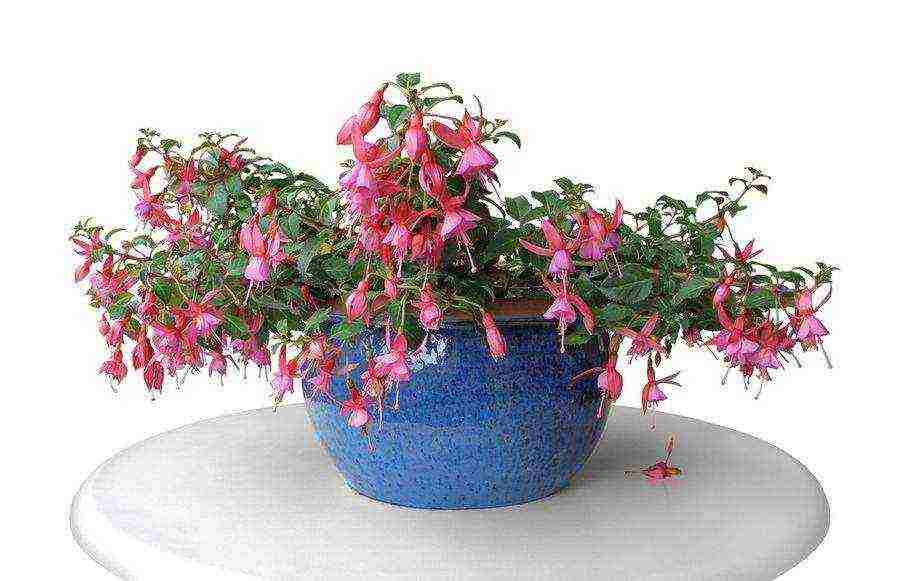
The first varieties of fuchsia have a bright pink-purple color.
The plant is viable, unpretentious. Fuchsia loves fresh air, so from May to September it decorates balconies, terraces, steps of country houses. Grow a flower in hanging pots or small pots.
Names of varieties of ampel forms popular in Russia:
- Blue Angel;
- Hollys Beauty;
- Bella Rosella;
- Blue Vale;
- Cecile.
These are ornamental plants with beautiful double inflorescences that can withstand partial shade and are not sensitive to the composition of the soil. Suitable for hanging baskets.
Description of the best varieties of world selection
Breeders of different countries are engaged in breeding fuchsia hybrids. Therefore, the plant is represented by hundreds of varieties with various colors of flowers, leaves and crown shape. Fuchsias bred in France and the United States are especially popular in world breeding.
- Alison Woods - semi-ampelous with flattened inflorescences, white and pink, hybrid 2001;
- Comet has been popular since 1963. The bush is 30 cm high, powerful, dense. Flowers are red-pink with a lilac skirt, terry. The plant is resistant to diseases and temperature extremes;
- Chalki Dops - a fast-growing hybrid of 2004. Semi-ampelous crown. Terry flowers, pink with a maroon variegated skirt;
- Deep Purpl is a semi-ampelous variety of 1989. The skirt is bright blue, the sepals are white, the inflorescence is dense, double;
- Lassi is a heat-resistant semi-ampelous hybrid. Elegant inflorescences are white with red, terry. It blooms profusely, therefore, at the end of the season, the buds become smaller, but do not lose their graceful decorative effect;
- Natasha Sinton - oblong inflorescences of a pale pink color with an ash tint. The crown is semi-ampelous, dense, covered with delicate buds.
Among collectors, old varieties, bred in the last century, are valued, distinguished by bright and rich shades of buds. Bush specimens are considered more capricious than hanging ones, therefore they are grown at home, and ampelous ones - on terraces, gazebos.
See also: a description of the primrose and its beneficial properties
Indoor flower fuchsia (Fuchsia) is a house plant that blooms with unusually beautiful flowers almost all year round. It got its name in honor of the German physician Leonard von Fuchs, one of the “fathers of botany”. Homeland is Central and South America. Fuchsia has been grown as an indoor flower for more than 200 years in the form of numerous hybrid varieties and forms. Florists have long fallen in love with this evergreen plant for its decorative effect, unpretentiousness, and vitality. And the beauty and variety of its colors is simply amazing.Sometimes, because of the shape of the flowers, fuchsia is called "Japanese lantern" or "Chinese lantern", and for its rare grace and bright purple color of curved petals, fuchsia is popularly called "Gypsy earrings". Fuchsia flowers come in different shapes and shades. Different types of fuchsias bloom at different times of the year. You can choose varieties so that a tropical garden will bloom almost all year round on your flower shelf.
Description of the plant
Fuchsia in nature looks like a shrub with flexible branches. Green or slightly reddish oval fuchsia leaves are opposite, pointed and serrated at the edges. The most important charm is given to the flower by its flowers - numerous, bizarre in shape and varied in color. Under the name "indoor fuchsia" means hybrid fuchsia (F. hybrida), which has hundreds of forms that differ in color and shape of flowers. Hybrid plant varieties amaze the imagination with their rich assortment. Hybrid flowers come in any size and color. Growing hybrid fuchsias is easy and convenient. They are unpretentious in care and extraordinarily beautiful. In addition, the plant can be given any shape: ampelous, in the form of a bush, in the form of a pyramid or a standard tree. In ampel varieties, the shoots are long and flexible. They are usually grown in hanging pots or graceful baskets.
To create a beautiful cascade of fuchsia flowers, several cuttings are planted in one wide flowerpot at once, and they are immediately placed closer to the edges and obliquely to give the future bush a falling shape. During the growth of the green mass, the basket is regularly turned towards the light in different directions - then the crown will form evenly and magnificently. Semi-ampelous varieties of fuchsia at first have the shape of a bush, but over time, under the weight of numerous buds and flowers, flexible stems begin to bend beautifully and hang over the edge of the pots. To prevent fragile twigs from breaking, they are tied to supports.
Indoor fuchsia blooms for a long time and abundantly drooping flowers. The flowers themselves are also large and small, double and not double, single and collected in a brush. Non-double flowers have 4-5 petals. Semi-double flowers are when there are 5 to 7 petals on a flower, while double flowers have 8 or more petals.
fuchsia structure
The structure of the flower is peculiar. It consists of a corolla-shaped calyx and a tubular corolla, from under which long bright stamens are visible. The lobes of the calyx are usually longer than the petals, and the stamens are longer than the calyx. In general, the flower looks like a ballerina doll in a lush or simple tutu skirt, which has spread its arms at the sides and is ready to whirl in a dance. (photo) Fuchsia flowers are located on long pedicels. Coloring of flowers is one-color, two-color, and sometimes, in one flower, there are three shades at once. The fuchsia fruit is an edible berry.
Often fashion designers or designers, when describing the color of a model, use in the name, for example, a dress or shoes of fuchsia color. The color of fuchsia is considered to be magenta magenta. In fact, it is a cumulative definition of several shades of magenta, ranging from light crimson to deep purple.
Also on our website you can read an article on how to grow fuchsia and take care of a flower at home.
Three-leafed (Fuchsia triphylla)
This fuchsia grows as a bush up to 60 cm in size. Since it grows in breadth, it is convenient to grow it in a hanging basket. Fuchsia leaves are 8 cm long. Their shape resembles that of an egg. The upper side of the leaf is reddish green and the underside is brownish red. A fluff is visible on the leaves along the veins. Three-leaf fuchsia flowers look like bells. Small fiery red sepals form multi-flowered inflorescences - brushes. Flowering is profuse and lasts from early May to October.In winter, this fuchsia must be kept in relative heat, at least 10 grams. But in summer it can withstand high temperatures and open sun. The most popular three-leaf fuchsia varieties are Thalia, Mantilla, Coralle, Elfriede Ott and others. This type of plant is used to create flower arrangements in living rooms, on loggias and balconies.
Waist (Thalia)
Has graceful bright orange flowers. An active and lush bloom continues throughout the spring and autumn.
Magellan (Fuchsia magellanica)
Tall evergreen shrub, reaching three meters in height. On the purple leaves of the plant, up to 4 cm in size, there is a fluff along the veins. This fuchsia blooms all spring and until October. Flowers are single or collected in inflorescences of 4 pieces.
Magellanic fuchsia tolerates low temperatures. You can leave it to winter on a glazed balcony, after cutting it to a height of 10 - 15cm. and covering, for example, with fallen leaves. Usually the plant is brought into the house for the winter, preferably in the coolest place. Watering fuchsia during the dormant period is necessary, but rarely.
This type of fuchsia is used to decorate arches, shop windows, glass on the veranda.
Lying (Fuchsia procumbens)
This creeping plant can be used for flower arrangements. The lonely flowers of the plant are always directed upward, as if reaching for the sun. Their shades range from pink to orange. This fuchsia blooms all spring and autumn.
Sparkling (Fuchsia fulgens)
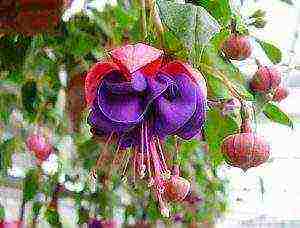
This tall bush, up to two meters in height, has large leaves with jagged edges, reddish stems and scarlet flowers. Bears fruit. The berries of the plant are edible and collected in a brush. The sparkling fuchsia blooms all summer and is used to create floral ensembles.
Graceful (Fuchsia gracilis)
This fuchsia is called the sister of Magellanic fuchsia, because in nature it can grow up to 3 meters. When grown indoors, the height of fuchsia reaches only one meter. Beautiful, usually large flowers of Graceful fuchsia, sit on thin, almost invisible stalks. Flowering lasts from spring to late autumn.
Shiny or Shiny (Fuchsia fulgens)
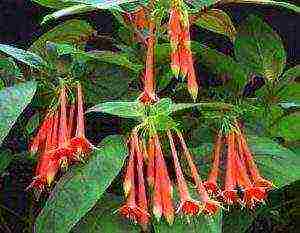
It looks like a graceful shrub. Stems are thin, flexible, reddish. The leaves are large, cordate-oval, with sharp jagged edges. The color of the leaves is purple-green. This fuchsia blooms from spring to autumn with bright crimson flowers with a crimson tint. Inflorescences are collected in bunches. Withered flowers must be cut off, the plant must be fed - then it will delight you with continuous lush flowering until the very cold weather.
Slendens (Fuchsia Splendens)

It is a highly leafy shrub. Blooms throughout the year. The flowers are in the form of a long red tube with green petals. It is believed that fuchsia of this variety has the largest fruits - up to 5 cm in length and the most delicious - with a lemon tart aroma of spices.
Bolivian (Fuchsia boliviana)
The plant came to us from Bolivia, Argentina, Peru. This fuchsia is considered one of the most beautiful and spectacular species. Reaches one meter in height. The leaves are large, pleasantly velvety to the touch. Bolivian fuchsia flowers are collected in extraordinary bunches. They are distinguished by the huge size of the peduncles (up to 30 cm), on which the flowers hanging down are gracefully attached. Flowers are red and white. This plant prefers to grow in shade or partial shade. Humidity is also important. He prefers to spend the winter in warm rooms, as he does not like cold temperatures. Bolivian fuchsia blooms from early March to late April.
Thin (Fuchsia macrostemma)

This type of fuchsia at home can grow up to 3 meters in height. But it can be cut off. Then, instead of stretching upward, it will expand in breadth. Fuchsia leaves have a reddish tint. It blooms from July to late September. Flowers on very thin and long peduncles are collected in clusters. The hue of flowers can be from light purple to violet.
Thyroid
This tall plant (up to three meters in height) has long and thin flowers, collected in a cluster. If you cut it off in time, it grows up to one meter. Fuchsia blooms from early July to October. The shade of flowers is pink, violet, purple. Use Shield Fuchsia to create flower arrangements in offices and greenhouses.
Bright red (Fuchsia coccinea)
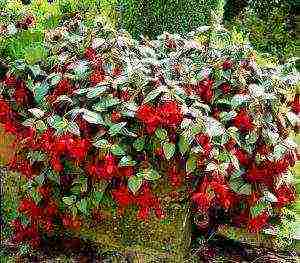
Bright red fuchsia has a long flowering - from the beginning of April to the end of October. This is a very beautiful plant. Its red flowers with purple accents are mesmerizing. You can grow such fuchsia both in a private apartment and in an office.
Alisson Bel
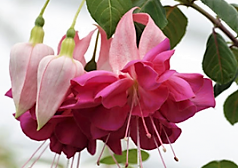
This fuchsia blooms for a long time in semi-double flowers of a violet-red hue.
Annabel
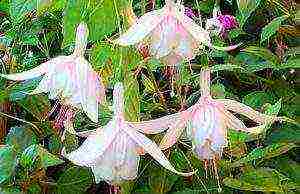
It blooms with huge white double flowers.
Ballerina
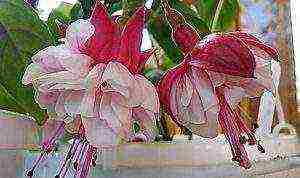
This fuchsia variety is distinguished by the fact that it has many small flowers with scarlet sepals and a pink and white skirt.
Henriette Ernst
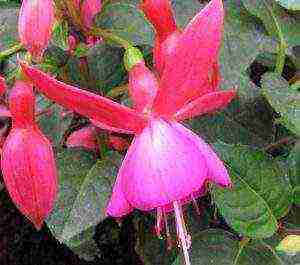
This fuchsia has large double flowers with scarlet sepals and a light lilac skirt.
Dancing Flame

There is a standard and bush form of the plant. The buds are large, elongated. Sepals are pink-orange. The skirt is bright pink with an orange tint. The flowers are semi-double. Abundant flowering. A very bright and elegant variety!
Coquet bell
This is a bush form of fuchsia. Flowers are large, not double, in the form of bells. The sepals are pink and the skirt is lilac.
Ampelnaya
Ampelnaya is one of the most popular forms of fuchsia. Flexible stems, cascading downward, are strewn with bright lantern flowers. In addition, ampelous varieties of fuchsia belong to shade-tolerant varieties of indoor plants. They are not demanding on the composition of the earthen soil and frequent watering. Looks beautiful in wicker pots or in elegant hanging baskets. Two-tone fuchsias look especially impressive, the flowers of which hang down from baskets or hanging pots.
Popular ampelous fuchsia varieties:
Blue Angel
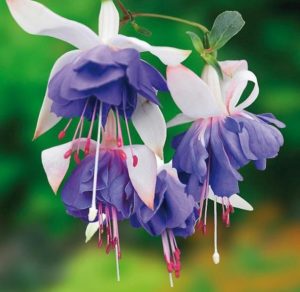
It has double flowers of lilac color on white sepals.
Holly's Beauty
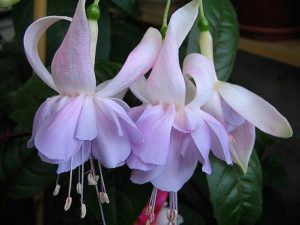
It has large, slightly elongated buds. The flowers are bright. Sepals are white. The skirt is lilac-blue.
Imperial Crown
Blooms profusely with elongated alo-pink flowers, which are collected in a cluster.
Prince of Peace
This variety is adorned with flowers formed by white sepals and a red skirt.
Archie owen

This semi-ample shape of fuchsia has pink sepals and a dark pink skirt. The buds are oblong. The flowers are very large, double.
Bella Rosella
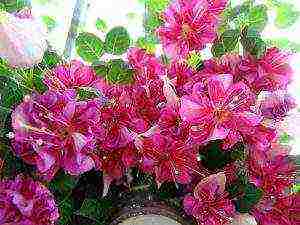
This fuchsia variety has a bush and ampelous bush form. Leaves are medium, green. The buds are oblong, large. The sepals are pink and the skirt is lilac. The flowers themselves are very large, double, unusually beautiful. This fuchsia is considered one of the largest flowering plants. It blooms profusely and for a long time.
Bicentennial
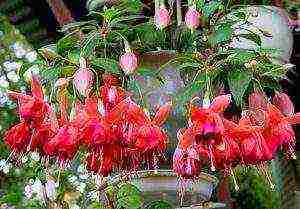
This is an ampelous form of fuchsia. Large buds are slightly oblong. Sepals are light, with time acquiring a delicate orange tint. The red skirt with salmon strokes also turns almost orange over time. The flowers are large, double, very beautiful.
Blue Mirage
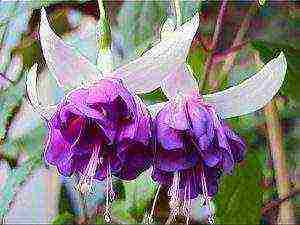
This fuchsia is ampelous and bush. Rounded buds. Double flowers are large. The sepals are white with greenish tips, and the skirt is bright purple with white strokes.
Blue Veil
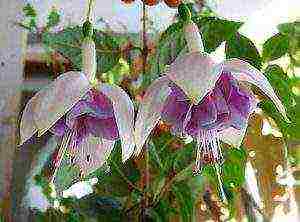
This fuchsia has a bush and ampelous shape. Rounded buds. Double flowers, large. Sepals are pure white with green tips. The skirt is lilac terry. Long and abundant flowering.
Cecile
It can be bush and ampelous. Flowers are densely doubled. The sepals are dark pink and the skirt is a deep lavender blue with wavy edges.
Conclusion
We introduced you to fuchsia of different varieties, shapes, colors and sizes. We hope that you will be able to choose for yourself such varieties that will delight you with their splendor all year round, deliver a minimum of hassle and maximum pleasure.
comments powered by HyperComments
Fuchsia home care
Fuchsia - (Fuchsia) refers to this. fireweed, or primrose (Onagraceae). Under natural conditions, fuchsia grows in the humid subtropics of Central and South America (Chile, Argentina), New Zealand.
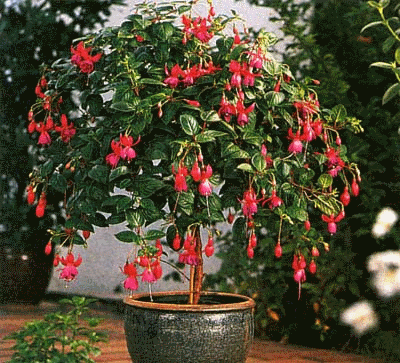 The first fuchsia, then called Fuchsia triphylla flore coccinea, was found in 1696 by the Frenchman Charles Plumier during his travels in America.
The first fuchsia, then called Fuchsia triphylla flore coccinea, was found in 1696 by the Frenchman Charles Plumier during his travels in America.
It was a stunted shrub with small, fiery red bell-shaped flowers and greenish-red leaves arranged in three in one node.Plumier named the plant fuchsia after the German botanist and physician Leonard Fuchs.
Later, another 12 species of fuchsia were introduced to Europe from New Zealand and South America, Chile and the West Indies. Of course, no one remained indifferent to the grace of the flowers of this plant. His procession around the world for several centuries was truly grandiose! Fuchsia adorned rich royal palaces and poor huts.
Natural species turned out to be extremely fertile material for breeders, and as a result of crossing and selection, there are currently more than 25 thousand varieties of fuchsia. They are so diverse that it seems that it is no longer possible to come up with something new. And, nevertheless, breeders continue to delight us with original, refined cultivars.
Due to its long and long flowering (from early spring to late autumn), a variety of growth forms (ampelous, erect, standard), simplicity and ease of maintenance, fuchsia is now one of the most popular crops among amateur flower growers. It is decorated with windows, winter gardens, balconies and loggias, and in the summer it is grown in the garden.
VARIETIES OF AMPEL FUCHSIA
`Golden Marinka`,` Guurtie`, `Baby Ping`,` Applause`, `Bicentennial`,` Impala`, `Fairy Tales`,` Glowing Lilac`, `Holiys Beauty`,` More Applause`, `Rohees King` ...
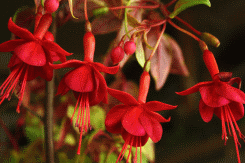 `Golden Marinka` |
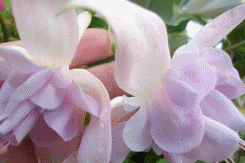 `Baby Ping` |
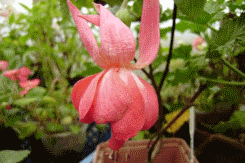 `Applause` |
 `Bicentennial` |
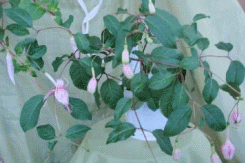 `Impala` |
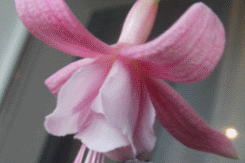 Fairy Tales |
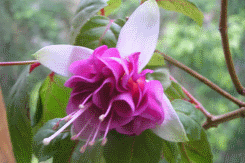 `Glowing Lilac` |
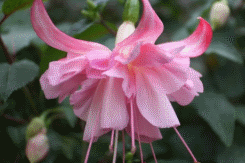 `Holiys Beauty` |
VARIETIES OF SEMI-AMPEL FUCHSIA
`Laurie`,` Cosmopolitan`, `Pinch Me`,` Rebecca Williamson`, `Ronees New Millennium`,` Veenlust`, `S`Wonderful`,` Marcus Graham`, `Cyndy Robyn`,` Play Boy`.
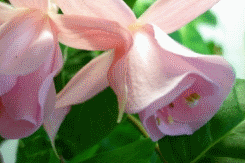 `Laurie` |
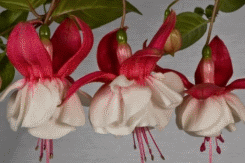 `Cosmopolitan` |
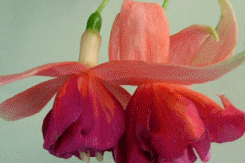 `Rebecca Williamson` |
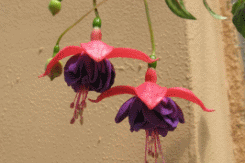 `Ronees New Millennium` |
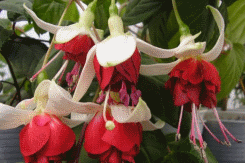 `Veenlust` |
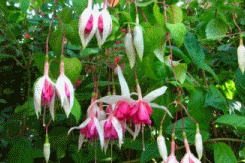 `S`Wonderful` |
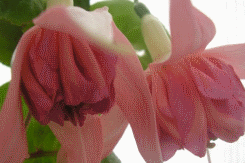 `Marcus Graham` |
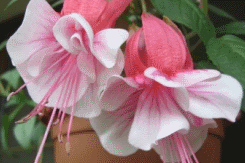 `Play Boy` |
VARIETIES OF BRUSH FUCHSIA
`Darking Angeles`,` Gillian Althea`, `Bohemienne`,` Comet`, `Pink Jade`, F.bolivienna var.pink cornet,` Moonraker`, `Green`n`Gold`,` Medallist`, `Satelitte` , `Gillian`,` Wilgelm Tell`, `Cotton Candy`,` Delta`s Ko`, `Nettala`,` Snowfire`, `Sweet Leilani`.
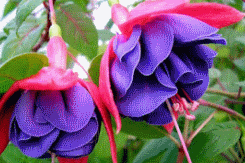 `Gillian Althea` |
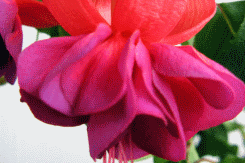 `Comet` |
 `Moonraker` |
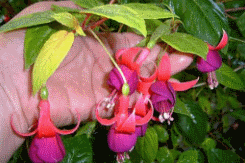 `Green`n`Gold` |
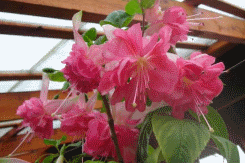 `Medallist` |
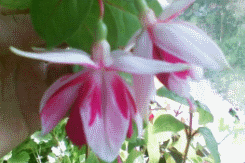 `Satelitte` |
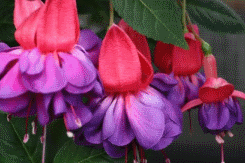 `Gillian` |
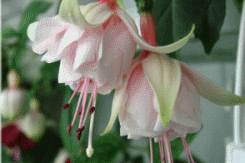 `Cotton Candy` |
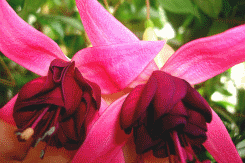 `Delta`s Ko` |
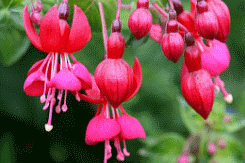 `Nettala` |
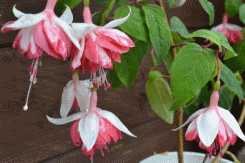 `Snowfire` |
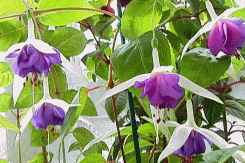 `Sweet Leilani` |
More material on the topic of the section:



